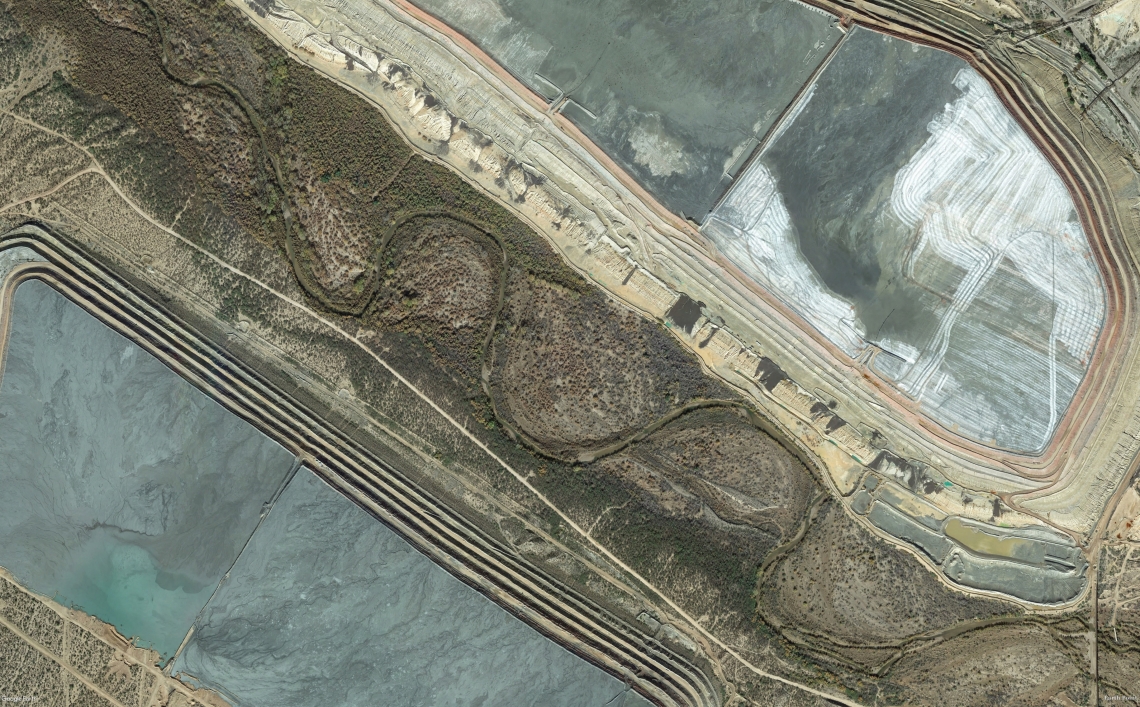A quick look at the Environmental Protection Agency’s Toxic Release Inventory map for the nation reveals a startling fact: The states with the largest waste streams per square mile are Utah and Nevada. Arizona’s not all that far behind. Who’s dumping all this stuff? Mining companies, that’s whom.
Nevada, Utah, and Arizona are all home to massive hardrock mines, and hardrock mines produce gargantuan quantities of solid waste.
Utah’s Bingham Canyon Mine, west of Salt Lake City, is the largest human-made excavation on earth. More than 1,000 tons of explosives are used daily to blast loose about 150,000 tons copper-bearing ore, which is then sent to the smelter to extract the metals. Copper makes up less than 1 percent of the ore, meaning the remaining 99 percent ends up as tailings, or waste, and is dumped in huge containment “ponds.”
In 2017, Kennecott, the owner of the mine and smelter, reported that they released more than 230 million pounds of chemicals, mostly in the form of tailings containing lead, arsenic, mercury, and other toxic materials. Newmont’s Twin Creeks Mine in Nevada spewed out a similarly huge stream of solid waste.
As nasty as these facilities might be, they do tend to be striking when seen from above, whether the viewer is looking out an airplane window or at Google Earth on her computer screen. One might even say that they are aesthetically appealing in a terrifying and sublime way. The following images are all from Google Earth.






Meanwhile, Peter Simons, a (fictional) character from my yet-to-be-published novel, Behind the Slickrock Curtain, isn’t too impressed. Here’s a dialogue between him and Eliza Santos about this sort of thing:
“Holy shit,” Peter said. “Check this out.” On his screen was a video showing an emerald green field slashed by what looked like a Tang-colored snake.
“What is that?” She asked.
“It’s the Animas Valley above Durango. Some mine spilled into the river and turned it orange. It’s nuts.”
“Huh,” she said, bristling a little at Peter’s enthusiasm. “That’s about what color Cement Creek is in Silverton almost all the time. It’s just iron.”
“Okay, but still, I don’t remember the river turning that color in Durango. Do you?”
“I guess not. But those mines leak nasty stuff into the river every day. You just can’t see it, usually. This is only different because it’s so colorful.”
“Huh. That is really interesting.”
“It’s not that interesting. People just don’t give a shit about pollution unless you hit them over the head with it, in a visceral way.”
“But don’t you see, Eliza? It’s the ultimate piece of land art. The spill, I mean. These guys from the EPA just made visible what always existed but that was unseen, and suddenly everyone’s freaking out. Everyone is a goddamned radical environmentalist now. It’s awesome. It’s art. It’s beautiful — that shade of orange against the green — and it’s sublime. So … original.”
“I don’t think they intended it that way. And even if they did, Burtynsky’s already done it.”
“No, no, no. Burtynsky takes pretty pictures of pollution, sure. He takes what is already quite visible and goes all high-def with it, makes it so dramatic that it becomes abstract, meaningless. It triggers aesthetic pleasure and moral despair, but no action. This is different. By making the invisible visible it is rousing people to action.”
She couldn’t deny him that. His conviction that the disaster was triggered intentionally for artistic purposes concerned her, but Eliza did her best to share his enthusiasm. At the library she dug up some essays by two land artists, Robert Smithson of Spiral Jetty fame, and Robert Morris. Both of them were interested in turning old mining and industrial sites and other environmental catastrophes into monumental works of art, but Smithson died before bringing his vision to fruition, and Morris’ dream of sculpting the colossal laceration known as the Bingham Canyon Mine was stifled by ongoing mining. Perhaps Peter could revive that effort.

